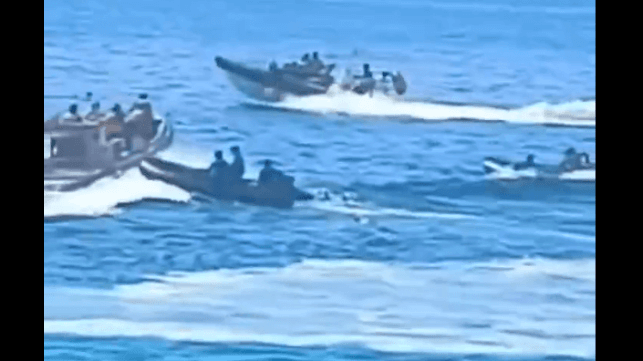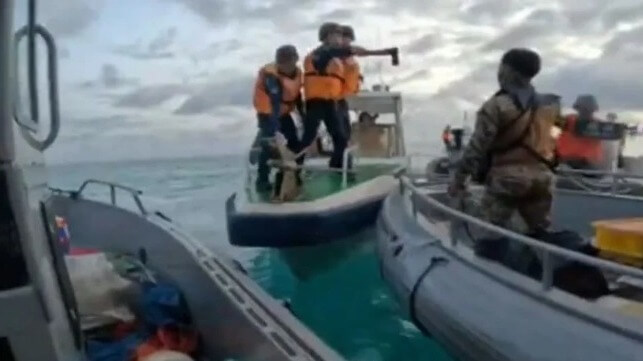WWIII
Report: China Coast Guard Stole Two Philippine Boats, Dumped Cargo

The altercation between Chinese and Philippine forces at Second Thomas Shoal earlier this week was much more serious than previously reported, officials in Manila acknowledged on Tuesday.
The Philippine armed forces have confirmed that a Filipino soldier had been severely injured when a China Coast Guard boat carried out an "intentional high-speed ramming" at Second Thomas Shoal early Monday morning. In an update Tuesday, two Philippine officials quietly acknowledged that at least eight soldiers were injured, including one who was seriously injured - and that the China Coast Guard towed off two Philippine Navy rubber boats.
According to the AP, two Philippine Navy boats were ferrying supplies to the outpost aboard the grounded landing ship BRP Sierra Madre when they were intercepted by several China Coast Guard speedboats. An altercation ensued, involving a "scuffle" and several collisions. In the fray, a Philippine servicemember lost a thumb, two officials told AP on condition of anonymity.
Contrary to previous formal statements, the officials said that the Philippine Coast Guard was present at the scene and moved in to rescue the injured personnel.
After the encounter, the China Coast Guard towed off the two rubber boats, dumped the contents over the side - including firearms - and abandoned them. Philippine Navy forces later recovered the boats, but not all of the cargo.
If the new account is accurate, the run-in is by far the most serious incident yet at Second Thomas Shoal, a contested flashpoint claimed by China and occupied by the Philippines (with international diplomatic and legal recognition). China has accused the Philippines of starting Monday's confrontation, alleging that Philippine vessels "dangerously approached a Chinese vessel in normal navigation in an unprofessional manner, resulting in a collision."
The AFP blamed the China Coast Guard for the incident and demanded de-escalation from the Chinese side.
"The CCG’s continued aggressive behavior and unprofessional conduct towards a legitimate humanitarian mission is unacceptable. They must restrain themselves to avoid escalating tensions," the Armed Forces of the Philippines said in a statement Tuesday evening.
The U.S. Department of State affirmed America's continued support of Philippine sovereignty and security, as guaranteed by the U.S.-Philippine Mutual Defense Treaty. Deputy Secretary of State Kurt Campbell reiterated that the treaty covers "armed attacks on Philippine armed forces . . . anywhere in the South China Sea."
Fears of Chinese activity off Luzon
Separately, local fishermen on the west coast of Luzon told Philippine outlet GMA that they spotted a suspected Chinese vessel within 20 nautical miles of the nation's main island - far closer in than Chinese forces normally venture.
"Last week we really saw [them] - they also disappeared so fast but it was scary," one fisherman told GMA.
Local residents are aware of the China Coast Guard's newly-enacted rules of engagement, which allow the CCG to arrest anyone suspected of breaking Chinese law in the Philippine exclusive economic zone. The measure allows the CCG to detain suspects for up to 60 days without charges. As a precaution, some fishermen are staying away from their traditional fishing grounds at Scarborough Shoal, a reef off Luzon that has been occupied by Chinese forces for 10 years.
"Maybe we will be caught and taken to China, so we will just be patient," Jeffrey Elad, President of the Tropical Fish Gatherer Association, told GMA.
U.S. Marine Corps carries out shore battery exercises on Luzon
On Monday, I Marine Expeditionary Force announced that a joint U.S. and Philippine force carried out a live-fire event off the coast of Cape Bojeador, on the northeast corner of Luzon. U.S. Marine Corps units provided coordination, and the Philippine Marine Corps (PMC) carried out artillery strikes on "staged maritime targets" about four miles offshore.
In an area just to the south, four U.S. Marine Corps F-35 fighters out of Clark Air Force Base conducted strikes on practice targets about three miles offshore. "The areas utilized for the littoral live-fire events were within Philippine territorial waters and stringent safety precautions were taken to ensure safe and responsible training execution," the Marine Corps said in a statement.
China's Coast Guard is Deliberately Creating Legal Ambiguity

[By Peter Leavy]
While laws should provide clarity and transparency, China’s recent orders regarding maritime jurisdiction appear to be deliberately based on ambiguity and uncertainty. This has become very evident in the past day after the latest clash with the Philippines in the South China Sea.
In seeking to gradually expand China’s maritime jurisdiction, the Chinese Communist Party last month announced the “Provisions on Administrative Enforcement Procedures for Coast Guard Agencies 2024”, known as CCG Order #3. This order gives China Coast Guard commanders significant new powers under Chinese domestic legislation, following the 2021 “Coast Guard Law of the People’s Republic of China” (CCG Law).
Ostensibly an effort to put a legal framework around China Coast Guard operations, the new law notably does not use accepted terms defined under the UN Convention on the Law of the Sea, such as “Territorial Sea” or “Exclusive Economic Zone”. To do so would have imposed clearly articulated rights and responsibilities, clarifying how China sees the maritime zones it claims. Instead, the CCG Law uses vague and uncertain language such as “sea areas under the jurisdiction of the People’s Republic of China” (Articles 3, 12) and participation “in major maritime rights protection” (Article 15), phrases which are not defined.
Adding to the uncertainty, it also allows for the use of force by coast guard vessels for acts that infringe on China’s national sovereignty or jurisdiction (Article 23).
The Chinese position is that the UN convention is only one tool in governing maritime affairs and that its scope is limited, allowing the CCP to claim “historical rights” that predate the convention. This claim was rejected by an international tribunal in 2016 – proceedings China refused to participate in – which also rejected the concept of the “nine-dash line” that underpins much of China’s maritime discussion.
Why is this important? CCG Order #3 entered force on 15 June 2024 and authorizes coast guard commanders to detain foreign vessels and persons in “waters under Chinese jurisdiction” for up to 30 days and 60 days if the issue is “complicated” (Article 257). In essence, this will allow the China Coast Guard to detain vessels on what the rest of the world views as high seas and in the EEZs of foreign countries where, under the UN convention, they enjoy high seas freedoms of navigation and overflight. Importantly, it also does not distinguish between state-owned and commercial vessels, leaving the option open for foreign coast guards or even naval vessels to be detained under the regulation.
CCP Order #3 is just the next step in the CCP’s drive to extend its control over the South China Sea. This effort has multiple prongs, including the re-writing of history, an increasingly assertive on-water presence, diplomatic and economic coercion, and the selective use of legal tools to seek advantage.
China has a history of using international law in ways that suit its interests. It cites the law to draw attention to others or facilitate its own actions when to its advantage, but claims the law is irrelevant when its actions violate those same laws. This is the very essence of “lawfare”. There are myriad examples of the CCP protesting the United States and other nations’ lawful naval activities (including Australian), yet they see no issue with their intelligence vessels monitoring major Western military exercises such as RIMPAC (from within the US EEZ) and Talisman Sabre (from within Australia’s EEZ). The United States and Australia do not protest these actions as they are lawful under the UN convention.
The timing of China’s announcement is also telling, coming just after a civilian-led “peace and solidarity resupply mission” to Scarborough Shoal and a massive Chinese drill designed to test People’s Liberation Army and China Coast Guard coordination in isolating Taiwan.
Indeed, just two days after CCG Order #3 went into effect, we saw more aggressive Chinese action against Philippine vessels attempting a re-supply mission, this time resulting in reported injuries to Philippine sailors. It is also worth noting that unlike the coast guards of most nations, which fall under civil authorities outside wartime, the China Coast Guard was transferred to the People’s Armed Police in 2018, reporting to the Central Military Commission, and is hence effectively under permanent military control.
CCG Order #3 is just another example of China’s attempts to exploit ambiguity whereby all aspects of national power – in the maritime sense, its navy, coast guard, People’s Armed Force Maritime Militia, fishing fleets and merchant marine – are coordinated in the pursuit of military objectives.
Some have called for the China Coast Guard to be formally declared a military service. But one way to reduce the power of CCP ambiguity while retaining the moral and legal distinction between civil and military affairs is for Western countries to collectively announce what types of behaviors will be treated as military activities, regardless of the vessels that undertake them. That way, much of the power of ambiguity upon which CCG Order #3 relies would be removed.
Peter Leavy retired from the Royal Australian Navy in 2024 after 40 years of service. He commanded HMAS Stuart and HMAS Sydney as well as the Australian Defence Force Academy. He also served as Australia’s naval attache to the United States and worked in the Navy’s strategic policy and futures area. He is a PhD candidate with the National Security College at the Australian National University, researching contemporary maritime strategies for medium powers and is the President of the Australian Naval Institute.
This article appears courtesy of The Lowy Interpreter and may be found in its original form here.
The opinions expressed herein are the author's and not necessarily those of The Maritime Executive.
No comments:
Post a Comment